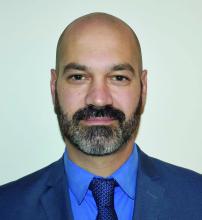Novel Antitumor Necrosis Factor (TNF) Antibody Plus GC Receptor Modulator Conjugate
A novel antibody-drug conjugate comprising the anti-TNF monoclonal antibody adalimumab (ABBV-3373) linked to a GC receptor modulator shows promise as a GC alternative.
A notable 2022 study authored by Frank Buttgereit, MD, and other researchers assessed its safety and efficacy in a randomized, double-blind, active-controlled, proof-of-concept trial.
ABBV-3373 “was designed to potentially allow precise targeting of activated immune cells while significantly dampening inflammation and minimizing the systemic side effects associated with glucocorticoids,” according to AbbVie, its manufacturer.
A total of 48 adults with moderate to severe rheumatoid arthritis receiving background methotrexate were randomized to receive either ABBV-3373 (n = 31) or adalimumab (n = 17). The novel drug at 12 weeks showed a −2.65 reduction in the Disease Activity Score in 28 joints using C-reactive protein, compared with −2.13 for adalimumab. Researchers also predicted ABBV-3373 to be more effective than adalimumab based on in-trial and historical adalimumab data.
“We have great expectations for this molecule,” said Giovanni Adami, MD, PhD, a rheumatologist at the University of Verona, Verona, Italy, who has coauthored several studies on the use of GCs. Plans are underway for a phase 3 study with ABBV-3373.
C5a and Interleukin (IL)-6 Receptor Inhibitors as GC-Sparing Drugs
Investigators in a 2021 paper explored whether the C5a receptor inhibitor avacopan could effectively treat patients with antineutrophil cytoplasmic antibody (ANCA)-associated vasculitis without the need for daily GCs, following treatment with either cyclophosphamide or rituximab. They randomized 331 patients to receive avacopan or prednisone given on a tapering schedule for 20 weeks (60 mg/d tapered to discontinuation by week 21). “Avacopan was noninferior but not superior to prednisone taper with respect to remission at week 26 and was superior to prednisone taper with respect to sustained remission at week 52,” the investigators summarized.
A longer trial should test avacopan’s safety and durability in patients with ANCA-associated vasculitis, they recommended.
Sarilumab, a human monoclonal antibody that binds IL-6 receptor alpha and blocks the IL-6 pathway, yielded good results in the phase 3 SAPHYR trial as an alternative for patients with PMR who relapse while tapering prednisone therapy.
Researchers in the SAPHYR trial randomly assigned 118 patients 1:1 to receive a twice-monthly subcutaneous injection of sarilumab over 52 weeks plus a 14-week prednisone taper or placebo plus a 52-week prednisone taper. Patients in each group received a tapered GC dose initially at 15 mg/d for 2 weeks in a blinded fashion to control for disease at baseline.
Sarilumab effectively sustained remission in patients, significantly reducing the GC dose compared with placebo.
Disease flare after clinical remission took place in 57% of patients in the placebo group, vs 24% in the sarilumab group. “The placebo-treated patients had a fairly traditional 52-week GC taper. The patients treated with sarilumab had a very rapid GC taper,” said lead study author Robert Spiera, MD, director of the Scleroderma, Vasculitis and Myositis Center at the Hospital for Special Surgery, New York City.
In his own practice, Dr. Spiera often treats his patients with new-onset PMR with a fairly rapid GC taper, akin to what was used in SAPHYR, recognizing that a portion of these patients can be successfully treated with a relatively brief course of GCs, although the majority will need to have “rescue” therapy for flares with that approach.
In SAPHYR, everyone had previously flared and started at 15 mg/d prednisone at study entry. “In my practice, I don’t always raise the prednisone to 15 mg for a PMR flare. I raise it to whatever dose is necessary to capture control of polymyalgia rheumatica symptoms as I add sarilumab. Often, that is less than 15 mg,” he clarified.
Patients with giant cell arteritis (GCA) also struggle to taper or stop using GCs. For these patients, the IL-6 receptor alpha inhibitor tocilizumab has demonstrated benefits in shortening the GC-tapering period.
In the GiACTA trial, researchers randomly assigned 251 patients in a 2:1:1:1 ratio with GCA to receive subcutaneous tocilizumab weekly or every other week, combined with a 26-week prednisone taper, or placebo combined with a prednisone taper over a period of either 26 weeks or 52 weeks. Patients in the tocilizumab arms combined with a 26-week prednisone taper had superior results with GC-free remission compared with those who underwent prednisone tapering plus placebo.
Subsequent studies have investigated the use of tocilizumab in shortening GC tapers. One pilot clinical trial assessed the use of tocilizumab monotherapy following ultrashort-term GC treatment (three pulses of 500 mg of methylprednisolone) in 18 patients with new-onset GCA. Researchers found that approximately 70% of patients were able to achieve and maintain disease remission for 52 weeks. One patient developed anterior ischemic optic neuropathy.
Another pilot study of 30 patients with GCA (50% new-onset disease, 50% relapsing disease) concluded that a year of tocilizumab combined with 8 weeks of prednisone could lead to remission. The majority of patients (77% of 30) maintained prednisone-free remission at 52 weeks, and no cases of anterior ischemic optic neuropathy were observed.
“The results of the studies mentioned above are encouraging and suggest that in the setting of IL-6 blockade treatment with tocilizumab, GC tapers shorter than 6 months may be possible. However, in order to be able to recommend short prednisone tapers in GCA, clinical trials comparing the efficacy and safety of different prednisone tapers [such as 8 vs 26 weeks] are required,” said Sebastian H. Unizony, MD, the study’s lead author and an assistant professor at Harvard Medical School and codirector of the Massachusetts General Hospital Rheumatology Vasculitis Program, Boston.
“The last several years have been a breakthrough period in GCA, which started with addition of tocilizumab to the therapeutic armamentarium against this disease and continued with several other agents showing promising results in phase 2 trials [of abatacept, mavrilimumab, and secukinumab] and a recently successful phase 3 trial with upadacitinib,” Dr. Unizony said.
Dr. Katz is a corporate officer and stockholder of Sparrow Pharmaceuticals. Dr. Adami has received speaker fees and/or has consulted for Galapagos, Theramex, Amgen, Eli Lilly, UCB, Fresenius Kabi, Bristol Myers Squibb, Abiogen, and Pfizer. Dr. Spiera has been a consultant for Roche-Genentech, GlaxoSmithKline, Sanofi, ChemoCentryx, Novartis, Galderma, Cytori, AstraZeneca, Amgen, and AbbVie, and has received research grant support from GlaxoSmithKline, Roche-Genentech, AstraZeneca, Bristol Myers Squibb, Kadmon, Boehringer Ingelheim, Cytori, ChemoCentryx, Corbus, Novartis, Amgen, and AbbVie.
A version of this article appeared on Medscape.com.



